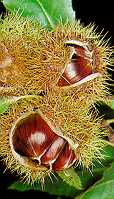View crop
View crop Data sheet EcoPortCastanea sativa
 |
|
| Notes |
|---|
| BRIEF DESCRIPTION A tall deciduous tree reaching up to 30 m in height. The leaves are simple, oblong-lanceolate, up to 22 cm long, coarsely serrate, the catkins erect. The fruit is a spiny 2-4-valved burl, containing 1-4 nuts. Nuts flattened to subglobose 1-3 cm in diameter. USES The nuts are eaten raw, roasted, boiled or dried, or ground and prepared into soup, chocolates, pastries, etc. The bark contains tannin. The wood is fairly easy to work and is used for broad carving, fencing, general carpentry and for the manufacture of cellulose. The tree is also planted as an ornamental and for erosion control. KILLING T Flowers will not tolerate frost. GROWING PERIOD Perennial deciduous tree. Grafted seedlings may bear after 2 years, and ungrafted seedlings after 8 years. COMMON NAMES Europaen chestnut, Spanish chestnut, Sweet chestnut, Marronnier, Kastanie, Chataigne, Chataignier, Castagna, Castana. FURTHER INF Scientific synonyms: C. vulgaris, C. vesca. European chestnut originated in the Mediterranean region from Italy to Iran. It require low to medium humidity in summer, and medium to high in winter. It require some winter chilling. In the Himalaya it can be found at elevations between 700 and 2000 m and in Indonesia at 1400 m latitude. The present average yield in California is about 2200 kg/ha, but new hig-yielding varieties are expected to yield 3360-4480 kg/ha. | Sources |
| SOURCES (C. sativa Miller) Roecklein J 1987 pp 326 [USE] Sims D (pers. comm.) Duke J 1975 pp 11 [PH, RAIN, TEMP] Woodroof J 1979 pp 232 [LIMIT, USE] Hackett C 1982 pp 148 [FER, PHO, DEP, PH, TEXT, TEMP] Troup R 1921 pp 951 Kerr G 1993 pp 11 Verheij E 1991 pp 324 [USE] Wickens G 1995 pp 21-23 [USE, DRA] |